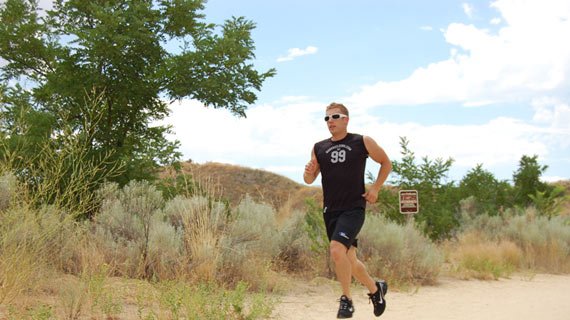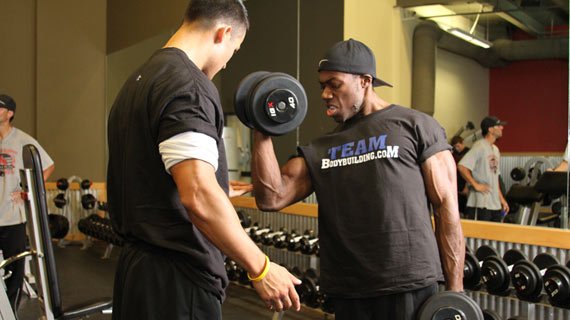The great training range (Muscle Mountain, Ripped Ridge) is marked by trails to bodybuilding's loftiest peaks: Peak training, Peak performance and Peaked biceps.
Unfortunately, many people spend their training life on a series of plateaus, looking up at those picturesque peaks, rather peering from atop them, like they should.
The most frustrating aspect of plateaus is that you might be working incredibly hard. You've climbed up to the plateau; that was no easy task. But, you aren't getting the results you wanted because you chose a program that saunters up a plateau, when you should initiate a plan that starts at the bottom of a mountain and gets you to the top.
You may begin to lose hope in the face of such a precipice in your path. Don't fret! When you get to the top, you won't even see the mountain beneath you. You will see beyond it (maybe to an even bigger mountain).
To climb and climb only to discover a plateau will try your mentality. But, load your pack with these techniques and those plateaus will be but pleasant pauses on your adventure up the fitness mountain.
Technique # 1: Swap Rep Ranges
Do you finish your daily 9-to-5 grind, only to head off to the gym for your 8-to-12 (reps) every night? There's nothing wrong with that range, to be sure; it's ideal for hypertrophy, or muscle building. But total physique development also requires strength building, which occurs in lower rep ranges, and muscular endurance training, which kicks in at higher reps.
Give your body a break. Move into a new rep range for a few weeks. If you are stuck on the plateau, you must change plans to climb higher. It'll be a fresh change of pace for your muscles and will force them to respond again.
Move back to the original rep range in a few weeks, and notice the change. You'll be surprised.
Technique # 2: Try a New Workout Split
A new workout split is another great plateau buster. If you follow the same full-body workout for 3 months and it stops working and slaps you down on a plateau, try an upper-body/lower-body split instead.
If you exercise on a 4-day split, try a twice-a-week, full-body split instead. Not only will your muscles enjoy the change of pace, but your mind will react positively to change!
Technique # 3: Crank Up the Intensity with Drop Sets
If you're an experienced lifter, you might need greater intensity to grab your muscles' attention.
One idea: drop sets. Take your set to failure or near failure, but the work doesn't end there. Instead, set the heavy weights down, pick up a lighter weight, and continue beyond failure.
Drop sets help you reduce gym time, tax a greater percentage of muscle fibers and experience better results.
Technique # 4: Do a Diet Inventory
When was the last time you did a major diet check-up? If it has been more than a month, do one right now. Your diet dictates results. If you do not eat right, progress will be hard to come by. When you climb the mountain, it constantly changes its terrain; change with it or stay where you are.
For example, if you aim to build muscle, it may be time for a calorie boost - enough of a surplus to spark new muscle growth. Perform a re-assessment every 6 to 8 weeks to maximize progress and avoid a plateau.
Technique # 5: Take Time Off
In some cases, taking time off from your training is the best way to improve results. You might not even realize you are overtraining until you take time off. On your way up the mountain, you must stop and admire the view to remember why you make the climb. After the short rests, you will come back bigger and stronger.
Training consistency is important, but hitting the weights hard in the gym every day can lead to fatigue, even burnout. Ultimately, your results will slow or stop.
Your body holds limited reserve energy for recovery. Deplete your reserves, and you ask for trouble. That's like mowing through all your supplies and then trying to continue the climb. If you reach that point, take a full week off from training. Light walking is fine, but nothing more than that.
You will likely come back feeling better than you did before, and the results will pour in.
Technique # 6: Check Your Form
Proper form is overlooked because many people assume they exercise properly. Often they're mistaken, moving through a workout with the strict know-how of Mr. Magoo, clumsily stumbling around in an earthquake.
If necessary, hire a personal trainer for a second set of eyes to make sure you correctly perform each lift. You may feel like you lift properly, but what we feel and what is true can be drastically different.
Have someone look over your shoulder to ensure you're on the right trail as you ascend toward your goal.
Parting Words for Pushing Past Plateaus
If you find yourself stuck on the same plane of training existence, take a look at your entire plan. Determine the seriousness of the situation.
Ask yourself these questions:
- Have you been stuck for a few days or a few weeks?
- Or has it been months since you can recall serious progress?
If it has only been a few days, relax slightly, because we all have bad weeks. It could mean you just need a few nights of good sleep.
If it has been weeks or months, it's an issue you must take seriously! The changes may not be drastic, but change is needed to avoid plateaus.
Make a choice: Do you want to reach a pleasant plateau and maybe get a valley view? Or is your goal mighty? Do you want to reach the pinnacle of the mountain and look over all the land? It is your choice.







